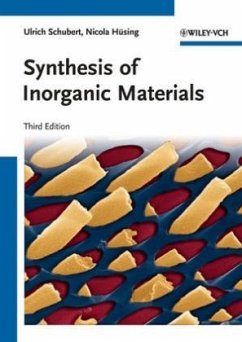Das populäre Lehrbuch wurde für die Neuauflage durchgehend überarbeitet, aktualisiert und um neue Anwendungsbeispiele aus der industriellen Synthesechemie ergänzt. Für Studenten und Forscher in den Bereichen Chemie und Materialwissenschaften.
This third edition of the popular textbook contains 30% new and/or revised content to reflect the latest developments in this fast developing field. Written from the chemist's point of view, the well-known and experienced authors provide a thorough and pedagogical introduction, now including examples of real-life applications of the syntheses, as well as new sections on nanomaterials, templating methods and biomineralization.
A valuable resource for advanced undergraduates as well as masters and graduate students in inorganic chemistry and materials science.
Due to their use and importance in many fields, a great deal of research focuses on developing inorganic materials. For example, a computer contains many types of inorganic materials, including the glass in the display or a layer of the LCD screen, the metal wires, and semiconductor materials in the chips and other electronic components. Computers can even be powered by solar cells, which also include inorganic materials. Zeolites also belong to this class and are found in applications ranging from catalysts to cat litter.
This third edition of the popular textbook contains 30% new and/or revised content to reflect the latest developments in this fast developing field. Written from the chemist s point of view, the well-known and experienced authors provide a thorough and pedagogical introduction, now including example real-life applications of the syntheses, as well as new sections on nanomaterials, templating methods and biomineralization.
A valuable resource for advanced undergraduates as well as masters and graduate students in inorganic chemistry and materials science.
This third edition of the popular textbook contains 30% new and/or revised content to reflect the latest developments in this fast developing field. Written from the chemist's point of view, the well-known and experienced authors provide a thorough and pedagogical introduction, now including examples of real-life applications of the syntheses, as well as new sections on nanomaterials, templating methods and biomineralization.
A valuable resource for advanced undergraduates as well as masters and graduate students in inorganic chemistry and materials science.
Due to their use and importance in many fields, a great deal of research focuses on developing inorganic materials. For example, a computer contains many types of inorganic materials, including the glass in the display or a layer of the LCD screen, the metal wires, and semiconductor materials in the chips and other electronic components. Computers can even be powered by solar cells, which also include inorganic materials. Zeolites also belong to this class and are found in applications ranging from catalysts to cat litter.
This third edition of the popular textbook contains 30% new and/or revised content to reflect the latest developments in this fast developing field. Written from the chemist s point of view, the well-known and experienced authors provide a thorough and pedagogical introduction, now including example real-life applications of the syntheses, as well as new sections on nanomaterials, templating methods and biomineralization.
A valuable resource for advanced undergraduates as well as masters and graduate students in inorganic chemistry and materials science.

